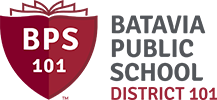Blended Learning
Teachers at BPS101 are shifting to a model of instruction that looks and feels different than a traditional classroom.
Why Blended Learning?
Batavia Public Schools commits to student learning by personalizing learning to meet the needs of all students and encouraging students to take ownership of their own success. The concept of personalized learning puts students at the center of the teaching and learning process and actively engages them in the process.
In a personalized learning environment, students receive “what they need when they need it” through differentiation, student choice, goal setting, and reflection. Experiences are personalized by adjusting the pace, path, and time of learning. Meaningful assessments, technology, learning resources, and a clear curriculum are essential components of quality, personalized learning.
In order to achieve a personalized learning environment for our students, the staff at BPS are using different instructional models such as blended learning.
Michael Horn and Heather Staker in Blended: Using Disruptive Innovation to Improve Schools (2015) detail the different instructional approaches that teachers might use to improve instruction. Examples include:
Rotational Model: This may include a station rotation that has small groups of students working on the technology, with the teacher, independently or with a collaborative team.
Flex Model: Students are engaged in online content as well as teacher-directed, in-class instruction.
A La Carte Model: This is a mix of the other two models of blended learning.
Based on their knowledge of the students and the content, the teacher will select or create a model that meets the instructional needs of the students. This is happening every day in classrooms across BPS101.



